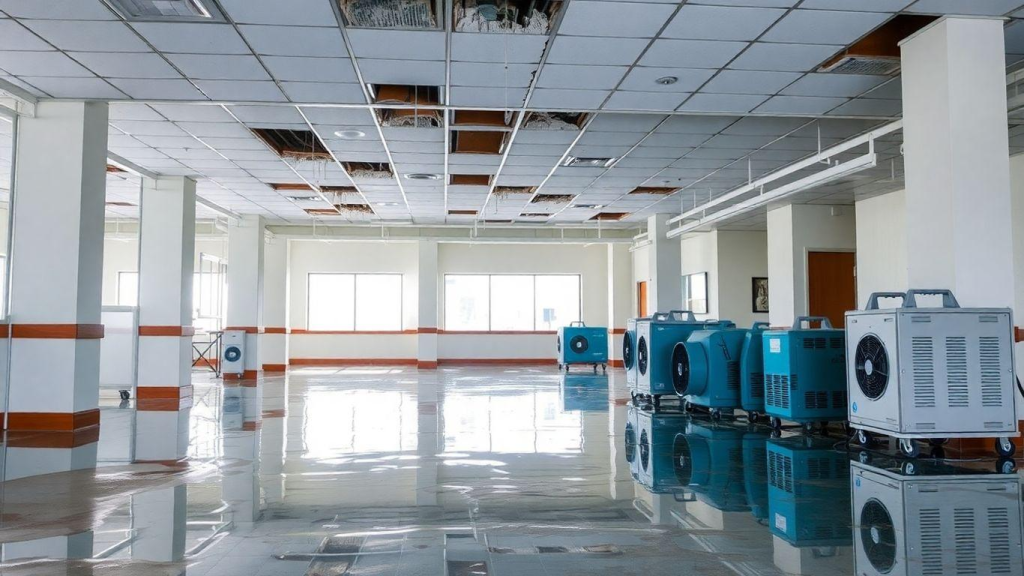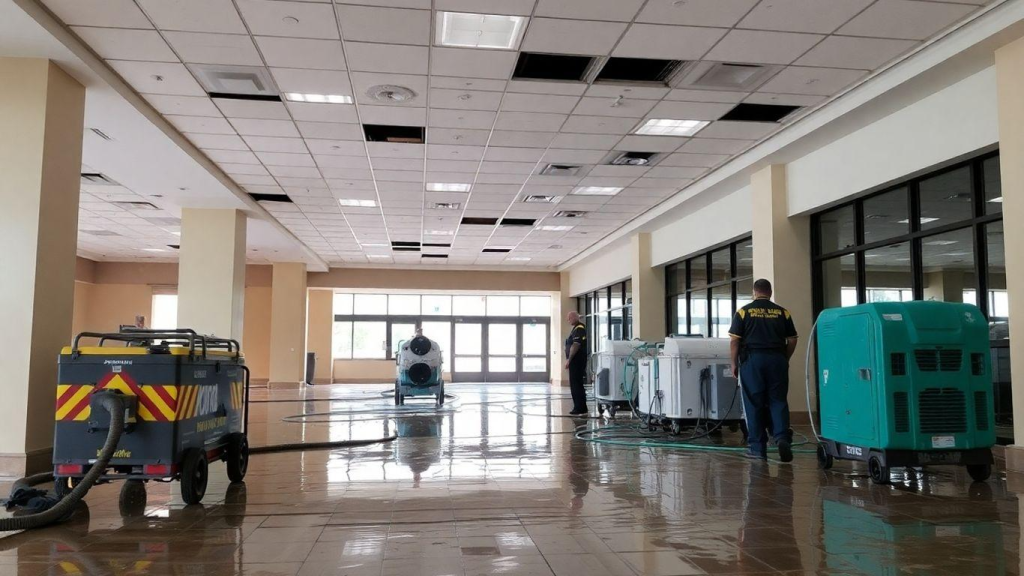Why Commercial Properties Need Specialized Water Damage Restoration Services
Water damage in commercial buildings isn’t just about mopping up puddles. It’s a serious issue that can halt business operations and cause significant financial strain. When water intrudes, it doesn’t just sit on the surface; it seeps into materials, creating hidden problems that can worsen over time. Professional water damage restoration is the process of not only removing the visible water but also thoroughly drying, cleaning, and repairing the affected areas to bring the property back to its original state. This process is far more involved than a simple cleanup, aiming to prevent future issues like mold and structural decay. It’s about getting your business back on its feet, fast.
The Meaning of Professional Water Damage Restoration
Professional water damage restoration goes beyond basic cleaning. It’s a systematic approach to address all aspects of water intrusion. This includes identifying the source of the water, extracting standing water, drying out all affected materials, and sanitizing the area to prevent health hazards. The goal is to restore the property to its pre-loss condition, not just make it look superficially dry. This thoroughness is what distinguishes professional services from DIY attempts or basic janitorial work. It’s a critical step for any business facing water-related issues.
Types of Water Damage Affecting Commercial Buildings
Commercial properties can face water damage from many sources. Roof leaks, burst pipes, HVAC malfunctions, and even overflowing toilets can all lead to significant problems. Natural disasters like floods also pose a major threat. Each type of water intrusion presents unique challenges. For instance, water from a clean pipe is different from water that has flowed through sewage. Understanding these differences is key to proper remediation. This is where the expertise of commercial water damage restoration professionals becomes indispensable.
Classifying Water Damage by Contamination Level
Water damage is often classified into three categories based on its contamination level. Category 1 is clean water, typically from a broken supply line. Category 2 is greywater, which contains some contaminants and can cause illness. Category 3 is blackwater, which is heavily contaminated and poses serious health risks, often originating from sewage. The classification dictates the safety protocols and cleaning methods used during the restoration process. Professionals must correctly identify the category to implement the appropriate measures, ensuring the safety of occupants and the effectiveness of the remediation. This classification is a vital part of commercial water damage restoration.
The Critical Role of Professional Water Damage Restoration

When water damage hits a commercial property, it’s more than just an inconvenience. It can seriously disrupt business operations, damage valuable assets, and even pose safety risks. This is where professional water damage restoration becomes incredibly important. Acting fast is key to getting things back to normal quickly.
Swift Recovery and Business Continuity
Time is money, especially in the business world. A quick response to water damage means less downtime for your company. Professional restoration teams understand this urgency. They work efficiently to extract water, dry out the affected areas, and begin repairs. This focused effort helps maintain business continuity, preventing prolonged closures that can lead to significant financial losses and damage your reputation. Getting your business back up and running smoothly is the main goal.
Comprehensive Water Damage Assessment
It’s not always obvious how bad water damage really is. Professionals bring a trained eye and specialized tools to the table. They conduct a thorough assessment to find the source of the water, check for hidden moisture, and evaluate the full extent of the damage to your building’s structure, equipment, and inventory. This detailed understanding is vital for creating an effective restoration plan tailored to your specific situation. Without this, you might miss critical issues.
Prevention of Secondary Damage from Water
Water damage doesn’t just stop once the water is gone. If not handled properly, it can lead to serious secondary problems. Mold can start growing in as little as 24 to 48 hours, creating unhealthy conditions and further structural damage. Professionals use advanced techniques and equipment to dry everything thoroughly and apply treatments to prevent mold and other issues. This proactive approach safeguards your property from long-term consequences, ensuring a safer and healthier environment for everyone who uses the building.
Specialized Services for Commercial Water Damage

When water damage hits a commercial building, it’s not just about mopping up puddles. It requires a specialized approach that goes beyond what a typical homeowner might handle. Commercial properties have unique structures, materials, and operational needs that demand expert attention to get back to normal.
Structural and Material Restoration
Water can wreak havoc on the very bones of a building. Think about drywall, insulation, flooring, and even the structural beams. These materials can weaken, warp, or rot when exposed to moisture for too long. Professional commercial water damage restoration teams know how to assess this damage properly. They can determine if a material can be salvaged or if it needs to be replaced. This careful evaluation prevents future problems, like mold or further structural compromise, down the line. Getting the structural and material restoration right is key to a lasting recovery.
Decontamination and Mold Remediation
Not all water is clean. Depending on the source, water can carry bacteria, sewage, or other contaminants. This is where decontamination becomes a critical step in commercial water damage restoration. Professionals use specialized cleaning agents and techniques to sanitize affected areas, making them safe for occupants. Furthermore, if water damage lingers, mold can start to grow. Mold isn’t just unsightly; it can cause health issues and further damage the building. Expert remediation services are needed to safely remove existing mold and prevent new growth. This decontamination process is vital for a healthy business environment.
Advanced Drying Techniques and Equipment
Simply removing standing water isn’t enough. The moisture hidden within walls, floors, and ceilings needs to be addressed. Commercial restoration companies have access to industrial-grade drying equipment that is far more powerful than anything available to consumers. High-speed air movers, large dehumidifiers, and specialized moisture meters are used to extract water vapor and dry out the building thoroughly. This advanced drying is crucial to prevent secondary damage, like mold and rot, and to ensure the building’s integrity is maintained. Without these specialized tools, drying can take weeks, if not months, and the risk of long-term issues increases significantly.
Addressing the Causes of Commercial Water Damage
Commercial properties face a variety of threats from water. Understanding where this water comes from is the first step in protecting your business. Ignoring the root causes can lead to repeated problems and escalating costs. It’s not just about cleaning up a mess; it’s about preventing the mess from happening in the first place.
Many issues can lead to water damage in commercial buildings. These range from simple plumbing leaks to major natural disasters. Each cause requires a different approach to both prevention and restoration. Identifying these common culprits helps property managers and business owners stay vigilant.
Swift action and proper identification of the source are key to minimizing damage. This section looks at the most frequent reasons water causes trouble for commercial spaces, helping you prepare and protect your investment. We’ll cover common plumbing and roof leak issues, HVAC malfunctions and appliance failures, and the impact of natural disasters and poor drainage systems.
Benefits of Partnering with Restoration Experts
When water damage strikes a commercial property, calling in the pros makes a big difference. It’s not just about mopping up water; it’s about getting your business back on its feet quickly and safely. Professional restoration teams bring a level of skill and equipment that simply can’t be matched by in-house staff or general contractors. They understand the unique challenges commercial buildings face and have the know-how to tackle them efficiently.
Partnering with restoration experts means you’re getting a team that knows exactly what to do, from the first drop of water to the final clean. They have specialized training and a deep understanding of how water affects different materials and structures. This knowledge is key to preventing further issues down the line. Think of it as an investment in your property’s future and your business’s continuity. Without this specialized help, you might end up with bigger problems and higher costs later on.
Choosing the right restoration company is a big decision. You want a team that’s not only skilled but also reliable and communicative. They should be able to handle everything from the initial assessment to the final touches, keeping you informed every step of the way. This kind of partnership helps minimize stress and ensures the job is done right the first time, protecting your investment and your peace of mind.
Proactive Measures for Commercial Properties
Preventing water damage in commercial buildings is always better than dealing with the aftermath. Taking steps to head off potential problems can save a lot of headaches and money down the line. It’s about being smart and staying ahead of the curve when it comes to your property’s upkeep.
Prioritizing Preventative Maintenance
Regular check-ups on your building’s systems are key. Think of it like taking your car in for oil changes. You need to keep an eye on plumbing, roofs, and HVAC units. Catching a small drip or a loose shingle early can stop a major disaster later. This kind of attention helps avoid bigger issues and keeps your property in good shape. It’s a smart way to protect your investment and keep things running smoothly.
- Plumbing: Inspect pipes for leaks, corrosion, or wear. Check water heaters and other fixtures regularly.
- Roofing: Schedule routine inspections to find and fix any damage or weak spots that could lead to leaks.
- HVAC: Ensure systems are clean and functioning correctly to prevent condensation buildup or leaks.
- Drainage: Keep gutters and downspouts clear of debris to ensure water flows away from the building.
Consistent, scheduled maintenance is the first line of defense against unexpected water damage. It’s not just about fixing things when they break; it’s about stopping them from breaking in the first place.
Implementing Emergency Response Plans
Even with the best maintenance, accidents happen. Having a solid plan in place for when water damage strikes is vital. This plan should outline who to call, what steps to take immediately, and how to communicate with staff and restoration professionals. A well-thought-out emergency response plan can significantly reduce the chaos and damage when an incident occurs. It helps everyone know their role and react quickly.
- Identify key personnel responsible for initial response.
- Keep a list of emergency contacts, including restoration services.
- Define clear communication channels for staff and stakeholders.
- Outline immediate actions to mitigate further damage.
Addressing Small Leaks Promptly
Don’t ignore those little drips or damp spots. What seems like a minor issue today can turn into a major problem very quickly. A small leak can weaken structures, encourage mold growth, and lead to much more extensive and costly repairs if left unchecked. Acting fast on any sign of water intrusion is a critical part of proactive property management. It shows you’re serious about protecting your commercial property from the damaging effects of water.
It’s important to remember that consistent attention to your building’s health is the best way to avoid costly water damage incidents. This proactive approach to water damage restoration and prevention saves time, money, and stress in the long run.
Don’t Wait When Water Strikes
Water damage in a business building isn’t just a messy problem; it can really mess with your operations and your money. Things like old pipes breaking or a leaky roof can cause a lot of trouble. When this happens, trying to fix it yourself or just waiting it out usually makes things worse. That’s why having pros who know how to handle commercial water damage is so important. They have the right tools and know-how to get things dry, clean, and safe again, fast. This helps keep your business running and stops small problems from turning into huge, expensive headaches down the road. So, if water damage hits your property, calling a specialized restoration service is the smart move to protect your investment and get back to normal as quickly as possible.




Leave a reply